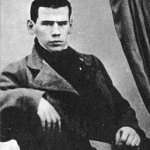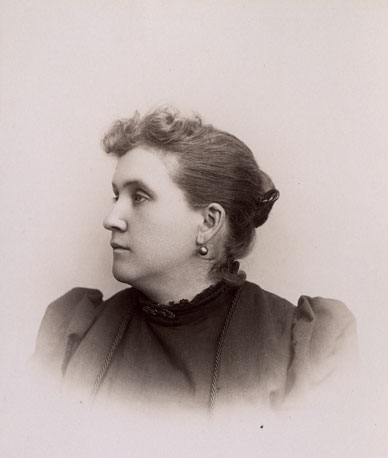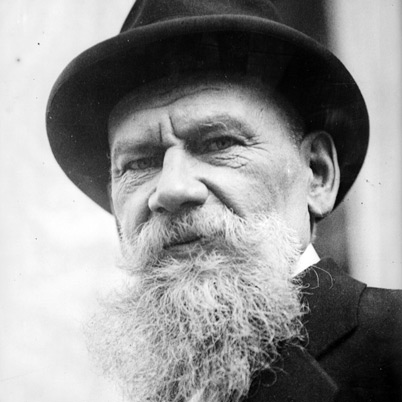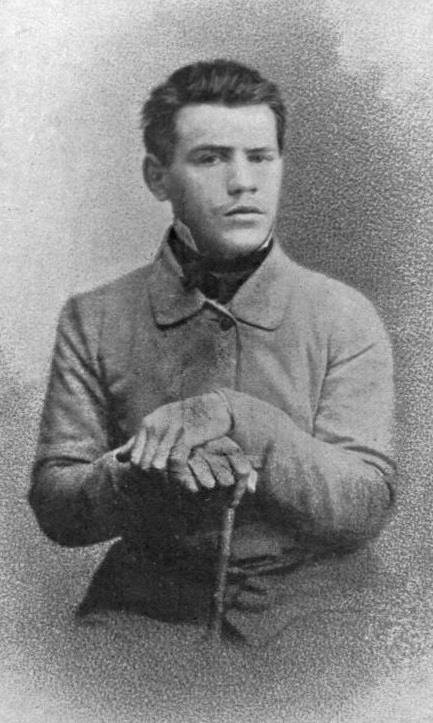Count Lev Nikolayevich Tolstoy, also known as Leo Tolstoy, born 9 September 1828 in Yasnaya Polyana, Russia, was a Russian writer, philosopher and political thinker who primarily wrote novels and short stories. It is said that Tolstoy referred to Yasnaya Polyana as his “inaccessible literary stronghold”. It was there that he penned two of his greatest literary works, War and Peace (1869) and Anna Karenina (1877), and also where he was buried upon his death in Lev Tolstoy, Russia on 20 November 1910. He is widely considered one of the greatest novelists of all time.
Tolstoy, Mormonism, and the “American Religion”
Leo Tolstoy wrote in his diary, “God is that infinite All of which man knows himself to be a finite part.”
The late Elder David B. Haight, serving as a member of the Quorum of the Twelve Apostles of The Church of Jesus Christ of Latter-day Saints, in his message titled “He Is Not Here. He Is Risen,” shared the account of a conversation in 1892 between Count Leo Tolstoy and Andrew D. White who was the United States Foreign Minister to Russia at that time.
In the course of that conversation, Tolstoy said to White, “I wish you would tell me about your American religion.” White replied that there is no state church in America and that each person is free to practice the religion of his choosing. Tolstoy, becoming somewhat annoyed, replied, “I know all of this, but I want to know about the American religion. … The church to which I refer originated in America and is commonly known as the Mormon Church. What can you tell me of the teachings of the Mormons?” White then admitted that he knew very little about the Mormons or their faith.
Tolstoy, displeased with the ambassador’s response, then said:
Dr. White, I am greatly surprised and disappointed that a man of your great learning and position should be so ignorant on this important subject. Their principles teach the people not only of heaven and its attendant glories, but how to live so that their social and economic relations with each other are placed on a sound basis. If the people follow the teachings of this church, nothing can stop their progress—it will be limitless.
There have been great movements started in the past but they have died or been modified before they reached maturity. If Mormonism is able to endure, unmodified, until it reaches the third and fourth generation, it is destined to become the greatest power the world has ever known.
A Special Gift from a Prophet’s Daughter
 Leo Tolstoy will long be remembered as a great novelist, short story writer, and dramatist, but perhaps what should be remembered most about this literary genius whom Russians consider to be of the same caliber as Shakespeare in world literature, is the fact that he was a thinker. In his middle-age years after facing a devastating life crisis, he became engrossed in reading, thinking about, and writing about the pressing ethical, social, and religious issues of his day, with particular concentration on religious issues. It is said that in his quest to find answers to religious and moral questions, he penned some 7,000 letters in his lifetime.
Leo Tolstoy will long be remembered as a great novelist, short story writer, and dramatist, but perhaps what should be remembered most about this literary genius whom Russians consider to be of the same caliber as Shakespeare in world literature, is the fact that he was a thinker. In his middle-age years after facing a devastating life crisis, he became engrossed in reading, thinking about, and writing about the pressing ethical, social, and religious issues of his day, with particular concentration on religious issues. It is said that in his quest to find answers to religious and moral questions, he penned some 7,000 letters in his lifetime.
Leland A. Fetzer, in his article titled “Tolstoy and Mormonism” wrote the following about Tolstoy:
One of the characteristics of Tolstoy’s thoughts in his later years, when he was convinced that his mission lay in the moral conversion of mankind, was a profound commitment to religious belief. Tolstoy was convinced, quite simply, that to live was to believe. He accepted the existence of God, and, indeed, without the surety of God’s presence, he says, he would have shot himself in the birch woods on his estate or hanged himself in his study; the existence of God justified his own existence. What is more, he believed that God is accessible to all men of all social classes and all races and the celebration of His presence might take many forms.
In his quest for religious truth he became acquainted with Mormonism. His first mention of the subject can be found in his diary when he was a young writer known only to Russian readers, as he was traveling in Western Europe in 1857. He wrote again on the subject in an essay published near the end of life in 1901.
There were no missionaries in Russia during Tolstoy’s lifetime, however, according to Emily Schmuhl, reporting for Mormon Times, Tolstoy had a copy of the Book of Mormon in the library at his estate, Yasnaya Polyana. How did he obtain this precious volume? Frederick and Nataliya Felt, who at that time were attending the Laurel Ward of the Silver Spring Stake in Washington, D.C. set out to find an answer to that question after being told about the Book of Mormon in Tolstoy’s library by a Russian member. They went to Yasnaya Polyana, now a Tolstoy museum located four hours south of Moscow, to learn more about the book. Nataliya had a vested interest because she was born in Moscow, Russia, and has knowledge of the language and the country’s rich literary history. In a Deseret News article dated 22 June 2010, she commented, “I knew and respected Tolstoy’s works before I joined (the church),” Nataliya said. “I was really happy to know such a talented writer took an interest in the church.”
The Deseret News article continues:
A librarian at the museum searched her records and photocopied a catalog reference to the Book of Mormon. “It identified the exact cabinet, shelf and volume number,” Frederick said.
More importantly, the reference indicated that the book was a gift given to Tolstoy by Susa Young Gates, daughter of Brigham Young, women’s rights advocate and a writer once referred to by R. Paul Cracroft as “the most versatile and prolific LDS writer ever to take up the pen in defense of her religion.”
“It was surprisingly heavy,” Frederick said. He identified the copy as an 1881 Second Electrotype Edition published in Liverpool, England.
Gates’ inscription simply read: “Count Leo Tolstoy, from Susa Young Gates. Salt Lake City, Utah.”
He noted that other than the inscription, there were no other notes on any of the pages.
The curator helped the Felts consult Tolstoy’s diary where they found an entry mentioning that he had received the book from Gates and had “read the book.”
It is not clear however, if Tolstoy read the Book in its entirety or only in part.
Tolstoy believed that worship of God and our approach to God can be varied, but that God is there — and accessible to all men of all classes and conditions. He was curious, and sought for religious truths wherever he went, with whatever group or nationality of people he encountered. Rejecting organized religion himself, he was known for his support of and concern for those who did strive to practice their religion — especially for religious minorities who were struggling or suffering persecution.
 Thus, his keen interest in Mormonism. Brigham Young’s daughter had been enthralled by an article that she had read in the June 1887 issue of Century, which was a leading magazine of that time. Prior to writing Tolstoy, he had spoken in an interview of the U.S. government’s measures to crush polygamy, and according to Leland A. Fetzer’s article “Tolstoy and Mormonism,” she was amazed and wrote Tolstoy that “extensive as your reading and knowledge is, it should still reach so far, and compass so seemingly small a factor in the world’s present history.”
Thus, his keen interest in Mormonism. Brigham Young’s daughter had been enthralled by an article that she had read in the June 1887 issue of Century, which was a leading magazine of that time. Prior to writing Tolstoy, he had spoken in an interview of the U.S. government’s measures to crush polygamy, and according to Leland A. Fetzer’s article “Tolstoy and Mormonism,” she was amazed and wrote Tolstoy that “extensive as your reading and knowledge is, it should still reach so far, and compass so seemingly small a factor in the world’s present history.”
She sent him a copy of the Book of Mormon along with her letter which told of the history of Mormons from their point of view. Susa sent a total of three letters to Tolstoy which were answered by his daughter, Tatyana, as was his custom in responding to correspondence. According to Fetzer’s article, Tolstoy referred to the “beautiful letter of the American woman” in his journal.
Although he found the letters to be intriguing, according to the 21 September 2014 Deseret News article “Leo Tolstoy’s view of Mormons as teaching ‘The American Religion,” “When he read the book Susa sent on Joseph Smith he found what he called deception in it, as he did in all organized religion.”
Leo Tolstoy: A Man of Deep Thought and Reasoning
When Tolstoy met with Andrew D. White in March of 1894, and the discussion turned to the subject of Mormonism, White recalled the following as published in McClure’s Magazine (April 1901) and quoted in “Tolstoy and Mormonism”:
He thought two thirds of their religion deception, but said that on the whole he preferred a religion which professed to have dug its sacred books out of the earth to one that pretended that they were let down from heaven … he spoke of the good reputation of the Mormons for chastity, and asked me to explain the hold of their religion upon women.
Thomas J. Yates, once a student at Cornell University, also shared his account of the meetings between Tolstoy and White which was published by the Improvement Era in February 1939. It is also reported that upon returning home, White secured a set of LDS Church works for the Cornell University library.
 Count Lev Nikolayevich Tolstoy was a thinker. And though he abhorred organized religion, he maintained a determined interest in Mormonism, and considered it to be a religion that would flourish and influence the world as no other religion ever had before. Of all the religious sects in America, Leo Tolstoy considered Mormonism to be the “American Religion.”
Count Lev Nikolayevich Tolstoy was a thinker. And though he abhorred organized religion, he maintained a determined interest in Mormonism, and considered it to be a religion that would flourish and influence the world as no other religion ever had before. Of all the religious sects in America, Leo Tolstoy considered Mormonism to be the “American Religion.”
About Keith L. Brown
Keith L. Brown is a convert to The Church of Jesus Christ of Latter-day Saints, having been born and raised Baptist. He was studying to be a Baptist minister at the time of his conversion to the LDS faith. He was baptized on 10 March 1998 in Reykjavik, Iceland while serving on active duty in the United States Navy in Keflavic, Iceland. He currently serves as the First Assistant to the High Priest Group for the Annapolis, Maryland Ward. He is a 30-year honorably retired United States Navy Veteran.


 Watch a video about the restoration of the gospel on lds.org
Watch a video about the restoration of the gospel on lds.org
And by their fruits ye shall know them
Tolstoy was a very smart guy to write a book as long as “War and Peace.
Even more admirable is the concepts of ethics and morality that book converys.
It’s really a nice and helppful piece off info.
I’m glad that yoou just shared this helpful information with us.
Please sray uus up to date like this. Thanks foor sharing.